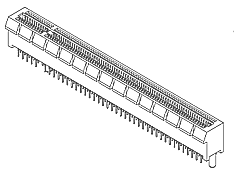Like AMD's Hypertransport
technology, PCI Express is a 2-way, serial connection that carries data in
packets, similar to the way it is transferred over Ethernet
connections.
The PCI
Express bus is no longer a single parallel data bus through which all
data is routed at a set rate. Rather, an assembly of serial, point-to-point
wired, individually clocked ‘lanes’ each consisting of two pairs of data lines
carries data upstream and downstream. As the technology goes to market, each of
these lanes is capable of a 2.5Gb/s data rate in each
direction. The overall sustained transfer rate roughly equals 250MB/s.
PCI Express was designed
with future upgrades in mind, and should see increased results with later enhancements.
Where the real performance benefit comes in is when more than one lane is added to
a given point-to-point route. Lanes can be stacked together to increase the
amount of bandwidth available to specific areas of the I/O system, such as the video card
slot, for example.
This technology has a couple of immediate benefits.
First of all, the amount of trace routes on any given
motherboard areconsiderably reduced by the adoption of point-to-point circuitry.
Using 4 routes instead of 32 for a basic connection, you can see how motherboard
manufacturers might well be enthusiastic about this technology, as this
would significantly cut the costs of producing motherboards in the long term.
Secondly, since each lane is exclusively used for communication between two
points, there is no sharing of the available bandwidth.
 The objective then, was
to create an I/O bus technology that
will
have the staying power that 32-bit PCI slots have enjoyed, a decade or more into the
future. It seems like it has been a success thus
far.
The objective then, was
to create an I/O bus technology that
will
have the staying power that 32-bit PCI slots have enjoyed, a decade or more into the
future. It seems like it has been a success thus
far.
Upcoming technologies such as Intel's multi-Gigabit Ethernet 'Dual Northway" chipset, will inevitably require
more bandwidth than PCI can currently offer, so its phasing out in the server
market seems inevitable.
The biggest impact that PCI Express has made on the
desktop market is with the PCIe x16 graphics slot. Found in the
latest Intel and AMD-based chipsets, This implementation
of the technology has virtually replaced AGP 8x as the platform of choice
for graphics card manufacturers. All new graphics cores from both nVidia and ATI support
PCI Express x16 by default, though some have been ported to AGP 8x.
The 164-pin X16 slot provides a total usable bandwidth
of around 4GB/s in each direction,
double the 2.1GB/s bandwidth that the 8x AGP spec boasts. The X16 specification is
pretty similar to AGP in terms of connector card size, though entirely non-compatible,
which gives it a boost in terms of familiarity and ease of installation.
nVidia has succeeded in creating dual-SLI graphics
technology using the PCIe x16 slot and its new
nForce 4 chipset
. This
technology allows two PCIe x16 slots to split
16 lanes of PCI Express into two sets of eight and
run two identical video cards in tandem. This leads to often dramatic boosts
in 3D gaming performance.
